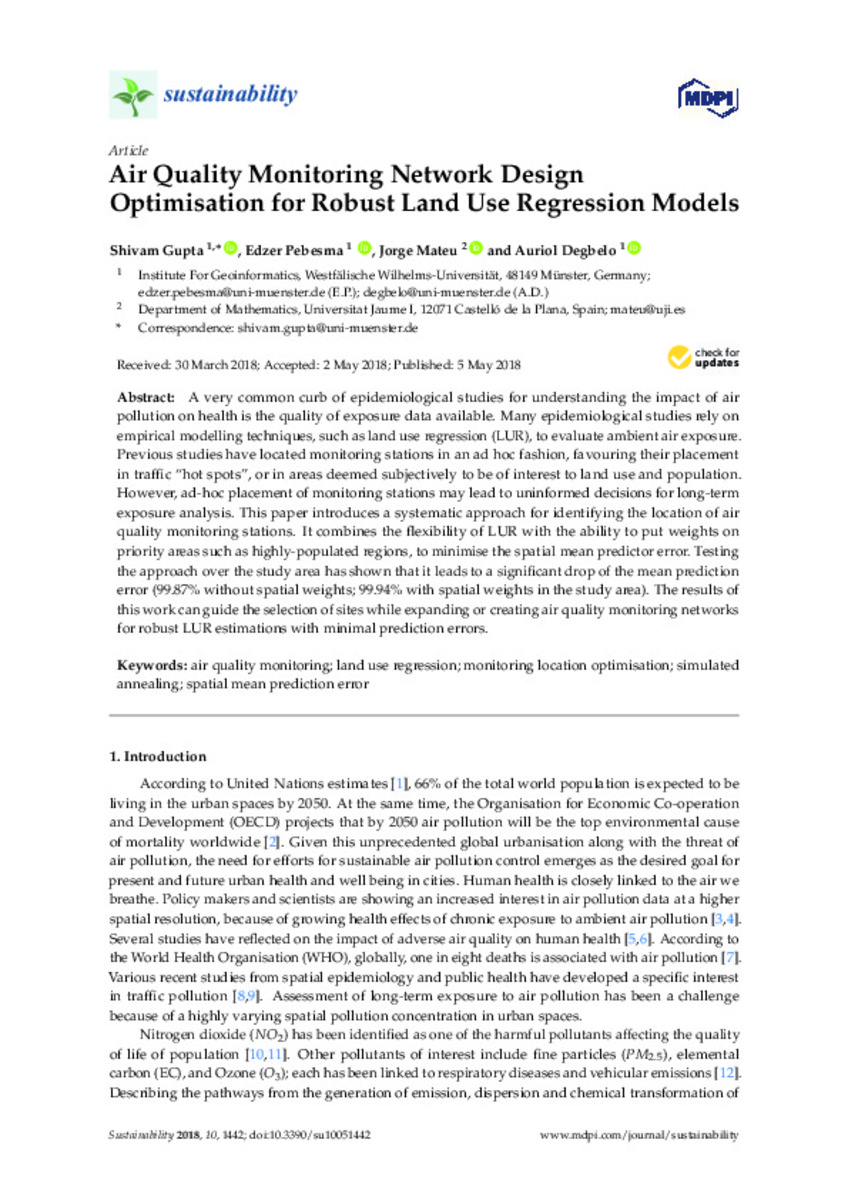Mostrar el registro sencillo del ítem
Air Quality Monitoring Network Design Optimisation for Robust Land Use Regression Models
| dc.contributor.author | Gupta, Shivam | |
| dc.contributor.author | Pebesma, Edzer | |
| dc.contributor.author | Mateu, Jorge | |
| dc.contributor.author | Degbelo, Auriol | |
| dc.date.accessioned | 2018-10-31T18:59:44Z | |
| dc.date.available | 2018-10-31T18:59:44Z | |
| dc.date.issued | 2018 | |
| dc.identifier.citation | GUPTA, Shivam, et al. Air Quality Monitoring Network Design Optimisation for Robust Land Use Regression Models. Sustainability (2071-1050), 2018, 10.5 | ca_CA |
| dc.identifier.issn | 2071-1050 | |
| dc.identifier.uri | http://hdl.handle.net/10234/177163 | |
| dc.description.abstract | A very common curb of epidemiological studies for understanding the impact of air pollution on health is the quality of exposure data available. Many epidemiological studies rely on empirical modelling techniques, such as land use regression (LUR), to evaluate ambient air exposure. Previous studies have located monitoring stations in an ad hoc fashion, favouring their placement in traffic “hot spots”, or in areas deemed subjectively to be of interest to land use and population. However, ad-hoc placement of monitoring stations may lead to uninformed decisions for long-term exposure analysis. This paper introduces a systematic approach for identifying the location of air quality monitoring stations. It combines the flexibility of LUR with the ability to put weights on priority areas such as highly-populated regions, to minimise the spatial mean predictor error. Testing the approach over the study area has shown that it leads to a significant drop of the mean prediction error (99.87% without spatial weights; 99.94% with spatial weights in the study area). The results of this work can guide the selection of sites while expanding or creating air quality monitoring networks for robust LUR estimations with minimal prediction errors. | ca_CA |
| dc.format.extent | 27 p. | ca_CA |
| dc.format.mimetype | application/pdf | ca_CA |
| dc.language.iso | eng | ca_CA |
| dc.publisher | MDPI | ca_CA |
| dc.relation.isPartOf | Sustainability, 2018, vol. 10, núm. 5 | ca_CA |
| dc.rights | © 2018 by the authors. Licensee MDPI, Basel, Switzerland. This article is an open access article distributed under the terms and conditions of the Creative Commons Attribution (CC BY) license (http://creativecommons.org/licenses/by/4.0/). | ca_CA |
| dc.rights | Atribución 4.0 Internacional | * |
| dc.rights.uri | http://creativecommons.org/licenses/by-sa/4.0/ | * |
| dc.subject | air quality monitoring | ca_CA |
| dc.subject | land use regression | ca_CA |
| dc.subject | monitoring location optimisation | ca_CA |
| dc.subject | simulated annealing | ca_CA |
| dc.subject | spatial mean prediction error | ca_CA |
| dc.title | Air Quality Monitoring Network Design Optimisation for Robust Land Use Regression Models | ca_CA |
| dc.type | info:eu-repo/semantics/article | ca_CA |
| dc.identifier.doi | https://doi.org/10.3390/su10051442 | |
| dc.relation.projectID | The authors gratefully acknowledge funding from the European Commission through the GEO-C project (H2020-MSCA-ITN-2014, Grant Agreement Number 642332, http://www.geo-c.eu/) | ca_CA |
| dc.rights.accessRights | info:eu-repo/semantics/openAccess | ca_CA |
| dc.relation.publisherVersion | https://www.mdpi.com/2071-1050/10/5/1442 | ca_CA |
| dc.type.version | info:eu-repo/semantics/publishedVersion | ca_CA |
Ficheros en el ítem
Este ítem aparece en la(s) siguiente(s) colección(ones)
-
INIT_Articles [748]
-
MAT_Articles [759]
Articles de publicacions periòdiques
Excepto si se señala otra cosa, la licencia del ítem se describe como: © 2018 by the authors. Licensee MDPI, Basel, Switzerland. This article is an open access
article distributed under the terms and conditions of the Creative Commons Attribution
(CC BY) license (http://creativecommons.org/licenses/by/4.0/).








